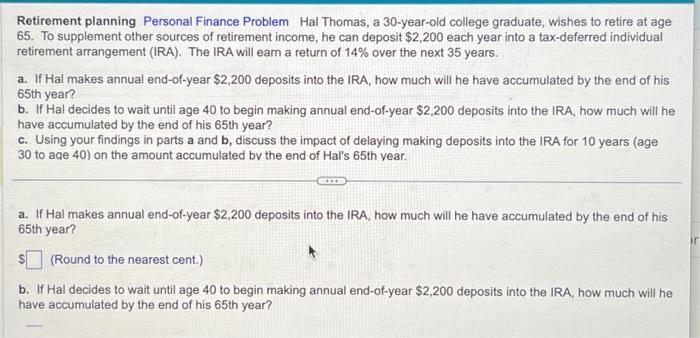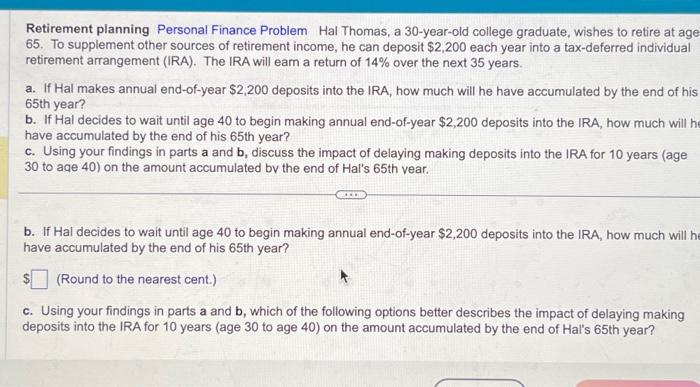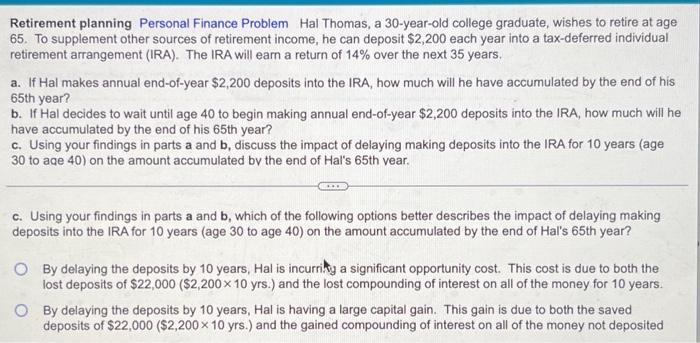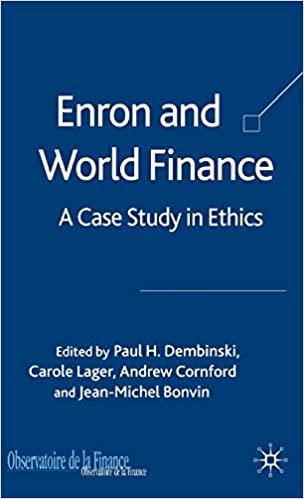Retirement planning Personal Finance Problem Hal Thomas, a 30-year-old college graduate, wishes to retire at age 65 . To supplement other sources of retirement income, he can deposit $2,200 each year into a tax-deferred individual retirement arrangement (IRA). The IRA will eam a return of 14% over the next 35 years. a. If Hal makes annual end-of-year $2,200 deposits into the IRA, how much will he have accumulated by the end of his 65 th year? b. If Hal decides to wait until age 40 to begin making annual end-of-year $2,200 deposits into the IRA, how much will he have accumulated by the end of his 65 th year? c. Using your findings in parts a and b, discuss the impact of delaying making deposits into the IRA for 10 years (age 30 to age 40 ) on the amount accumulated by the end of Hal's 65 th vear. a. If Hal makes annual end-of-year $2,200 deposits into the IRA, how much will he have accumulated by the end of his 65 th year? (Round to the nearest cent.) b. If Hal decides to wait until age 40 to begin making annual end-of-year $2,200 deposits into the IRA, how much will he have accumulated by the end of his 65 th year? Retirement planning Personal Finance Problem Hal Thomas, a 30-year-old college graduate, wishes to retire at age 65 . To supplement other sources of retirement income, he can deposit $2,200 each year into a tax-deferred individual retirement arrangement (IRA). The IRA will eam a return of 14% over the next 35 years. a. If Hal makes annual end-of-year $2,200 deposits into the IRA, how much will he have accumulated by the end of his 65 th year? b. If Hal decides to wait until age 40 to begin making annual end-of-year $2,200 deposits into the IRA, how much will h have accumulated by the end of his 65 th year? c. Using your findings in parts a and b, discuss the impact of delaying making deposits into the IRA for 10 years (age 30 to age 40 ) on the amount accumulated bv the end of Hal's 65 th vear. b. If Hal decides to wait until age 40 to begin making annual end-of-year $2,200 deposits into the IRA, how much will h have accumulated by the end of his 65 th year? $ (Round to the nearest cent.) c. Using your findings in parts a and b, which of the following options better describes the impact of delaying making deposits into the IRA for 10 years (age 30 to age 40 ) on the amount accumulated by the end of Hal's 65 th year? Retirement planning. Personal Finance Problem Hal Thomas, a 30 -year-old college graduate, wishes to retire at age 65 . To supplement other sources of retirement income, he can deposit $2,200 each year into a tax-deferred individual retirement arrangement (IRA). The IRA will earn a return of 14% over the next 35 years. a. If Hal makes annual end-of-year $2,200 deposits into the IRA, how much will he have accumulated by the end of his 65 th year? b. If Hal decides to wait until age 40 to begin making annual end-of-year $2,200 deposits into the IRA, how much will he have accumulated by the end of his 65 th year? c. Using your findings in parts a and b, discuss the impact of delaying making deposits into the IRA for 10 years (age 30 to ace 40 ) on the amount accumulated by the end of Hal's 65 th vear. c. Using your findings in parts a and b, which of the following options better describes the impact of delaying making deposits into the IRA for 10 years (age 30 to age 40 ) on the amount accumulated by the end of Hal's 65 th year? By delaying the deposits by 10 years, Hal is incurrity a significant opportunity cost. This cost is due to both the lost deposits of $22,000 ( $2,20010 yrs.) and the lost compounding of interest on all of the money for 10 years. By delaying the deposits by 10 years, Hal is having a large capital gain. This gain is due to both the saved deposits of $22,000 ( $2,20010 yrs.) and the gained compounding of interest on all of the money not deposited









